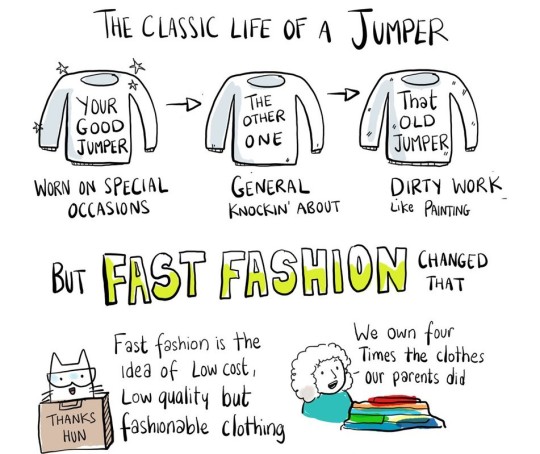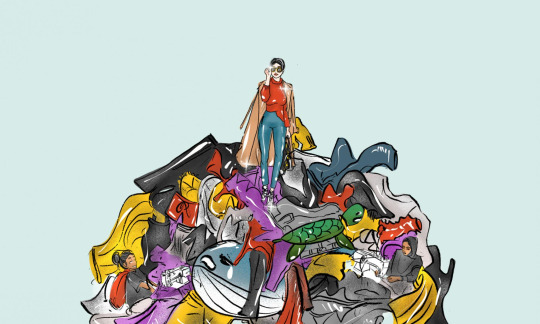Text
In recent times, sustainable living has become something very important, and people are taking various steps to reduce environmental, social and health impacts by being careful about what they use and how they use it. However, we also still live in the era of overconsumption culture and capitalism, so while some people try to take a step forward towards doing good, there are many more who make society take several steps backwards. One of the prevalent issues that encompasses unsustainability, overconsumption culture and capitalism, and is detrimental to the environment and society, is the concept of fast fashion.

The Fast Fashion Model
Fast fashion is a term given to the strategy that involves designing, manufacturing and marketing large quantities of clothing and accessories quickly. The sole purpose of the fast fashion model is to replicate trends from the runway and red carpets to supply in department stores for the public.
Some of the most famous mass-market fast fashion brands are H&M, Zara and GAP, who have been repeatedly criticised for their unethical and unsustainable business model, and continue to violate environmental as well as social ethics.
Why has fast fashion become a problem?
Fast fashion has a very short shelf-life for two main reasons - the compromise on quality and the focus on short-term trends.
The higher production rate ultimately results in cost savings. Brands produce clothing in a hasty manner and market extremely low-quality goods. Fast-fashion items are frequently discarded after only a few wears, and the manufacturing process leaves much to be desired. The same sense of haste that ignores quality also keeps the price of these clothes incredibly low.
Fast fashion focuses on trends over very short periods of time, which means people can acquire garments that are similar to what is trending because of the most recent fashion shows and discard them after wearing them a couple of times. This model is primarily aimed at the school and college-going crowd, where importance is given to looking "cool and trendy" as opposed to environmental and social justice and realising the adverse effects their consumption patterns have on the maintenance of this justice.
How bad is fast fashion?
From what you have read until now, if it seems like this practice is wasteful, wait till you hear just how wasteful the fashion industry is because of fast fashion. In a recent study by the Global Fashion Agenda, an organisation that envisions and works toward a sustainable future for the fashion industry, in the past decade, it was estimated the industry produced around 92 million tons of textile waste per year, which was primarily attributed to fast fashion garments. The research goes on to point out that if this trend of overconsumption and disposal continues at the same rate, by this decade, textile waste would increase to 148 million tons annually.

To make matters worse, all the textile waste is either dumped in landfills or incinerated. In landfills, these clothes, being mostly made of synthetic fibres, would not disintegrate quickly and would instead leach toxic chemicals into the ground. Burning the garments is just as bad because the toxic gases and smoke released into the atmosphere are detrimental to the survival of living beings in the environment.
Due to the enormous volume of products these firms sell, they generate millions of dollars while offering things at low prices. In addition to compromising on the quality of the materials used to cut costs, it is undeniable that the wages of garment workers are much below the minimum wage. Women and children from the Indian Sub-Continent are the primary victims of the fast fashion model as those from this country are seen as cheap labour. There is no regard given to maintaining a decent work environment or fixed working hours and the workers are made to work more than the stipulated hours for no extra pay. In addition to this, the women are often subjected to brutal violence by supervisors, making the fast fashion sector a medium for gender-based violence, to which most corporations turn a blind eye.
While consumers themselves do not feel like fast fashion costs them much, this concept has enormous costs hidden away from the public eye in the form of environmental and social costs. Novelist and journalist Lucy Siegle worded it well in the documentary The True Cost - “Fast fashion isn’t free. Someone, somewhere is paying”.
Who is involved in the fast fashion model?
As is the case in most industries, there are many players involved in the fast fashion model.
Firstly, there are corporations, motivated by capitalism and profit-making, who have a significant role in the increase of fast fashion. These corporations like Shein, Forever 21, Zara and H&M lack ethical responsibility and focus primarily on money, which is where the production of low-cost garments stems from, as they would be able to produce more for less and garner a more extensive consumer base.
There are also people like us, consumers, who are involved in fast fashion as most people get caught into the world of trends and buy these garments which last for a short period. To make up for those clothes, we buy more cheap clothes, and this cycle continues, resulting in us playing into the overconsumption culture and generating large amounts of waste.
We cannot forget the workers in the textile industry as players involved in the fast fashion sector. Almost every single piece of clothing has their overworked, underpaid and violated hands imprinted on them and marks the indecency and unethical behaviour of fast fashion corporations. This highlights the injustices in the society like no other.

Where is the effect of fast fashion observed?
There is no single place where fast fashion has an effect. Rather, this is a global issue of injustices of all kinds. However, in India, we see a large number of corporations having factories where fast fashion garments are made.
One of these factories happens to be in a locality of the city, Bengaluru, where workers, as mentioned before, are made to work overtime in difficult working conditions. The taxing environment leads to the dissatisfaction of these workers, but they have no choice but to work as per the instructions of their supervisors because at the end of the day, their job is their bread and butter. The people in this factory are one group of many in the sub-continent who face injustices.
In addition to this, being so close to the outskirts of the city, this locality is also a dumping ground for textile waste. It started with just waste material and rejected garments from the factory and has grown since, which can be very disturbing for the residents nearby.
The future of fast fashion
If the ongoing trend continues, fast fashion is predicted to worsenthe environmental and social impacts. Most corporations say they are doing better but are simply greenwashing their products by misleading consumers about their contribution to sustainability. Buying these products is just as bad as buying regular products from their brand and does not have any positive effect on the environment of society.
People are very slow in their action towards adopting more sustainable and ethical forms of fashion, so even though, as individuals, we take a few steps forward, the fast fashion model is running ahead. It will be quite a long journey to initiate positive action in the fashion industry and requires a lot of advocacy for workers and human rights from the public, and moves from within corporations to change motives and focus on positive impact rather than injustices.

References:
Global Fashion Agenda. (2017). Pulse of the Fashion Industry 2017.
Rauturier, S. (2022). What Is Fast Fashion and Why Is It So Bad? Good On You. https://goodonyou.eco/what-is-fast-fashion/
Stanton, A. (2022). What Does Fast Fashion Mean, Anyway? The Good Trade. https://www.thegoodtrade.com/features/what-is-fast-fashion
Yousefi, Y. (2020). Environmental and Social Impacts of Fast Fashion. The Sustainable Development Watch. https://sdwatch.eu/2020/02/environmental-and-social-impacts-of-fast-fashion/
7 notes
·
View notes